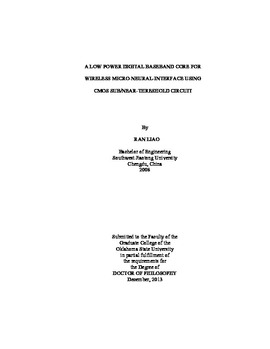| dc.contributor.advisor | Hutchens, Chriswell G. | |
| dc.contributor.author | Liao, Ran | |
| dc.date.accessioned | 2015-06-17T20:06:45Z | |
| dc.date.available | 2015-06-17T20:06:45Z | |
| dc.date.issued | 2013-12 | |
| dc.identifier.uri | https://hdl.handle.net/11244/14967 | |
| dc.description.abstract | This thesis presents the work on designing and implementing a low power digital baseband core with custom-tailored protocol for wirelessly powered Micro-Neural-Interface (MNI) System-on-Chip (SoC) to be implanted within the skull to record cortical neural activities. The core, on the tag end of distributed sensors, is designed to control the operation of individual MNI and communicate and control MNI devices implanted across the brain using received downlink commands from external base station and store/dump targeted neural data uplink in an energy efficient manner. The application specific protocol defines three modes (Time Stamp Mode, Streaming Mode and Snippet Mode) to extract neural signals with on-chip signal conditioning and discrimination. In Time Stamp Mode, Streaming Mode and Snippet Mode, the core executes basic on-chip spike discrimination and compression, real-time monitoring and segment capturing of neural signals so single spike timing as well as inter-spike timing can be retrieved with high temporal and spatial resolution. To implement the core control logic using sub/near-threshold logic, a novel digital design methodology is proposed which considers INWE (Inverse-Narrow-Width-Effect), RSCE (Reverse-Short-Channel-Effect) and variation comprehensively to size the transistor width and length accordingly to achieve close-to-optimum digital circuits. Ultra-low-power cell library containing 67 cells including physical cells and decoupling capacitor cells using the optimum fingers is designed, laid-out, characterized, and abstracted. A robust on-chip sense-amp-less SRAM memory (8X32 size) for storing neural data is implemented using 8T topology and LVT fingers. The design is validated with silicon tapeout and measurement shows the digital baseband core works at 400mV and 1.28 MHz system clock with an average power consumption of 2.2 μW, resulting in highest reported communication power efficiency of 290Kbps/μW to date. | |
| dc.format | application/pdf | |
| dc.language | en_US | |
| dc.rights | Copyright is held by the author who has granted the Oklahoma State University Library the non-exclusive right to share this material in its institutional repository. Contact Digital Library Services at lib-dls@okstate.edu or 405-744-9161 for the permission policy on the use, reproduction or distribution of this material. | |
| dc.title | Low power digital baseband core for wireless Micro-Neural-Interface using CMOS sub/near-threshold circuit | |
| dc.contributor.committeeMember | Scheets, George | |
| dc.contributor.committeeMember | Stine, James E., Jr. | |
| dc.contributor.committeeMember | Bukkapatnam, Satish T. S. | |
| osu.filename | Liao_okstate_0664D_13070.pdf | |
| osu.accesstype | Open Access | |
| dc.type.genre | Dissertation | |
| dc.type.material | Text | |
| dc.subject.keywords | cmos | |
| dc.subject.keywords | low power | |
| dc.subject.keywords | neural interface | |
| dc.subject.keywords | protocol | |
| dc.subject.keywords | sub/near-threshold | |
| thesis.degree.discipline | Electrical Engineering | |
| thesis.degree.grantor | Oklahoma State University | |
